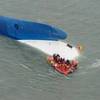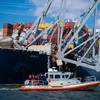From Commander, Naval Surface Force Atlantic Public Affairs
Rear Adm. Kevin M. Quinn relieved Rear Adm. D.C. Curtis as Commander, Naval Surface Force, Atlantic, (SURFLANT) Feb. 22, during a ceremony aboard the multi-purpose amphibious assault ship USS Wasp (LHD 1) at Naval Station Norfolk.
The ceremony marked the end of a successful tour for Curtis, a native of Chicago, who made priorities of warfighting readiness, the Navy of the future, and personnel readiness.
During his tour, he oversaw the continued development of the Surface Warfare Enterprise. As the Enterprise's chief readiness officer, Curtis led the establishment of eight Surface Force Class Squadrons (CLASSRONs) responsible for manning, training, equipping, maintaining, and sustaining ships by class for the entire force.
The CLASSRONs reaped immediate efficiencies by bringing to bear the skills and talents of focused groups of subject matter experts who identify class-wide issues, and use that knowledge to improve warfighting readiness.
Under Curtis' leadership, a number of innovative new technologies were brought to fruition and placed in the hands of Sailors and combatant commanders. That included the fleet introduction of the Navy's newest class of combatant ships, LPD-17. The staff brought USS San Antonio (LPD 17) into commission and successfully shepherded the ship through acceptance and shakedown trials, maintenance, and inspections.
His staff also assisted in the development of requirements for the Littoral Combat Ship (LCS), Zumwalt-class guided-missile destroyers (DDG 1000), the Joint High Speed Vessel, and Maritime Prepositioning Force Ship programs.
Curtis helped the surface force become a more effective workplace with a renewed emphasis on pride and professionalism. The return of Surface Line Week to Hampton Roads invigorated community camaraderie and energized leadership. The Surface Force Midshipman training program was completely reorganized and injected with enthusiasm, meaningful training, and leadership, resulting in a continued upward trend in post-cruise satisfaction surveys and the highest midshipmen interest in the Surface Warfare community in years.
Additionally, commanders training Symposiums, career management seminars, bimonthly leadership calls, afloat culture workshops, Commanding Officer newsletters, join-ups, a program of outreach and engagement with surface force families, and many more initiatives proactively united the waterfront at all levels on mission accomplishment resulting in improved warfighting readiness and quality of service.
A native of Chicago, Quinn graduated with a bachelor's degree from the U.S. Naval Academy in 1977. During his 30-year career, Quinn has served with distinction at sea and ashore.
At sea he served in three ships before becoming executive officer of the guided-missile cruiser USS Lake Champlain (CG 57). Since then, he has commanded the guided-missile destroyer USS Barry (DDG 52), Destroyer Squadron 28, Task Force 73/Logistics Group Western Pacific, and Carrier Strike Group 3 (USS Stennis Strike Group).
Ashore, Quinn has served as Aide to Commander, Naval Surface Force, Pacific Fleet; as Head of the Contingency Cell and Strike Leader Attack Training Syllabus instructor at the Naval Strike Warfare Center; as senior member of the Commander in Chief's Initiatives Team on the Special Staff of the CinC, U.S. Transportation Command; as Branch Head for Land Attack Warfare (N864) on the Chief of Naval Operations' staff; and as Executive Assistant to Commander, Atlantic Fleet/Commander, Fleet Forces Command.
Quinn is a distinguished graduate of the Naval Postgraduate School, graduating with a master's degree in information science. He also attended the Surface Warfare Officer Department Head School, graduating first in his class and receiving the City of Newport and Navy League Award. He completed his Joint Service education at the Armed Forces Staff College.
His awards include the Legion of Merit (5), the Defense Meritorious Service Medal, the Meritorious Service Medal (3), the Navy Commendation Medal (2), the Navy Achievement Medal, and various campaign and unit decorations. He is also a recipient of the Commander, U.S. Pacific Fleet's Shiphandler of the Year Award.
SURFLANT is a U.S. Navy type command and is made up of nearly 100 ships, and more than 30 special mission and support commands. SURFLANT Sailors and civilian employees are stationed both stateside – from Bath, Maine to Corpus Christi, Texas – and overseas – from Gaeta, Italy to Sasebo, Japan.
SURFLANT was established in 1975 as a consolidation of the Atlantic Fleet's Cruiser-Destroyer, Amphibious, Service, and Mine Forces. The command's mission is to man, equip, train, and maintain forward deployed, combat-credible forces.
Sponsored Content
Chris-Marine’s solutions help to prolong engine lifetime

AST is now AST Networks, bringing you remote connectivity wherever you are

March 2024
 Read the Magazine
Read the Magazine

 Read the Magazine
Read the Magazine
This issue sponsored by:

Dredging: Plenty of Issues, New WRDA on the Way
March 2024
 Read the Magazine
Read the Magazine

 Read the Magazine
Read the Magazine
This issue sponsored by:

A New Era of Flexibility for Water Injection Dredging
Subscribe for
Maritime Reporter E-News
Maritime Reporter E-News is the maritime industry's largest circulation and most authoritative ENews Service, delivered to your Email five times per week










